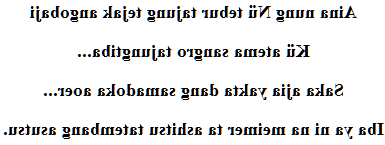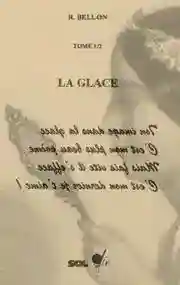Ao love poem
Aina
Aina nung Nü tebur tajung tejak angobaji
Kü atema sangro tajungtiba ...
Saka ajia yakta dang samadoka aoer ...
Iba ya ni na meimer ta ashitsu tatembang asutsu.


→ French poem ←
Chungli Ao language
Chungli Ao love poem (other possibilities : Ao, Chungli, Chongli, Aorr, Changki, Cholimi, Dordar, Uri, Yacham, Hatigoria, Longla, Mongsen Khari, Nowgong, Paimi), in the main dialect this Naga language the Chungli Ao.
They will be 170,000 to be able to read my little poem translated into this Tibetan-Burmese language.
Chungli Ao is the main dialect of Ao a Naga language, spoken in the Mokokchung district of Nagaland, a mountainous state in northeastern India, the other dialect is Ao Mongsen.
The Aos are Nagas. Their legend makes them descend from the Zungis and Ahoms peoples who settled in the region hundreds of years ago. Many Ahoms eventually left the hills to settle in the valley, and the Aos remained in a village called Zungi Imti.
The Mungsens who lived very close to them ended up mixing with them, through mixed marriages.
In some villages, we still find the two dialects (zungi (chungli) and mungsen (mongsen)) which coexist, while in others, it is one or the other that has remained, but the one that remaining dominant is the chungli.
Today there are around 170,000 speakers of the Ao language, with around 100,000 speakers of Chungli and 70,000 of Mongsen.
Before the arrival of the Europeans, the Nagas did not write, they have since adopted the modified Latin alphabet, and their language is beginning to be studied. The other languages of the Nagas are: sangtam (thukumi), yimchungrü (yachumi) and lotha (lhota).
Nagaland
Nagaland is a mountainous region located at the northeastern tip of India.
The Nagas still have practices and customs that have not changed a lot for a millennium, and still live in a very traditional way.
I remember in anthropology, a photo showing one of their huts (Morung), on the front of which, there were all the horns of the buffaloes which the owner had been able to have shot down, displayed in a very ostentatious way.
All this to show the important role of ostentation in the human adventure! Their raised stones, which are frequently found, even in areas where their high density has called them "stonehenge naga", seem to demonstrate the ostentatious importance of this phenomenon which is found in many cultures.
The Nagas are organized into tribes, they live, from agriculture on burning, and from rice fields, they are mongoloids.